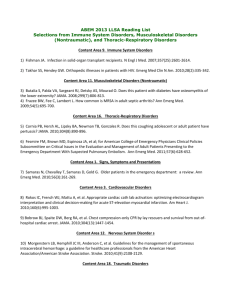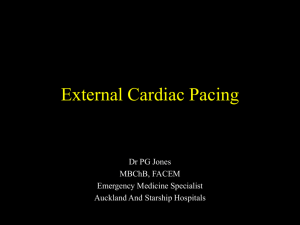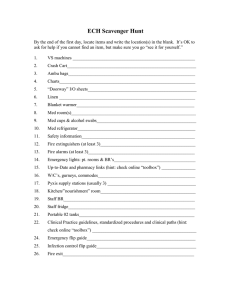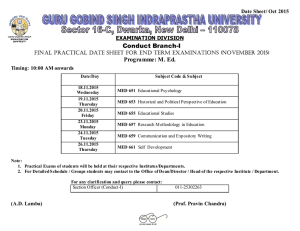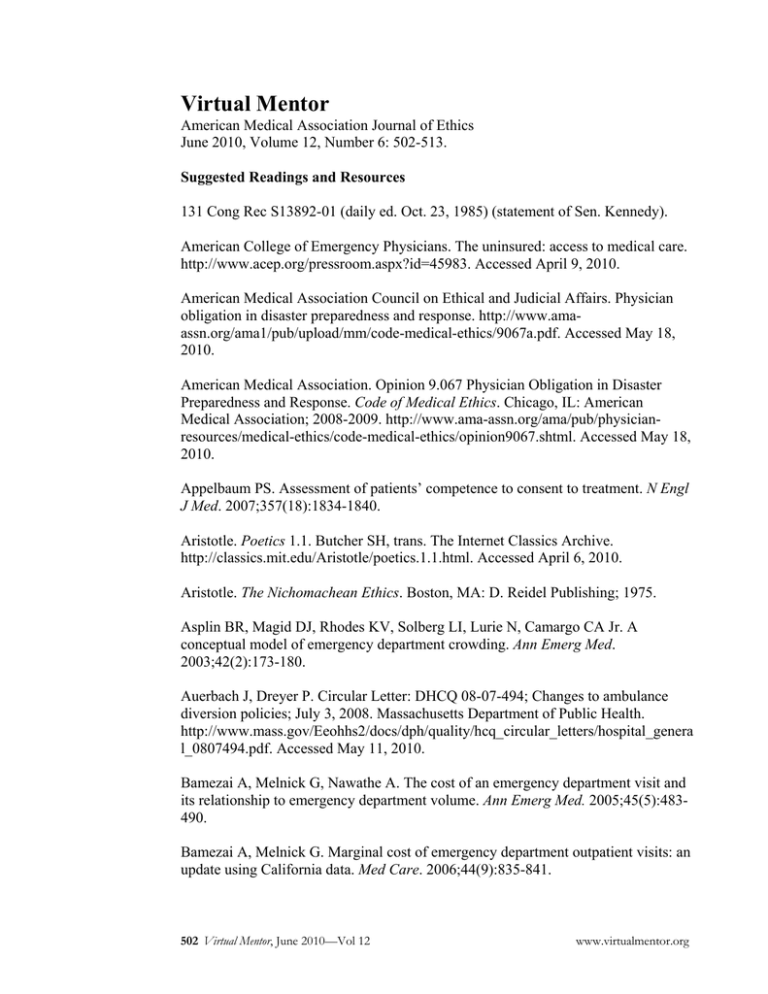
Virtual Mentor
American Medical Association Journal of Ethics
June 2010, Volume 12, Number 6: 502-513.
Suggested Readings and Resources
131 Cong Rec S13892-01 (daily ed. Oct. 23, 1985) (statement of Sen. Kennedy).
American College of Emergency Physicians. The uninsured: access to medical care.
http://www.acep.org/pressroom.aspx?id=45983. Accessed April 9, 2010.
American Medical Association Council on Ethical and Judicial Affairs. Physician
obligation in disaster preparedness and response. http://www.amaassn.org/ama1/pub/upload/mm/code-medical-ethics/9067a.pdf. Accessed May 18,
2010.
American Medical Association. Opinion 9.067 Physician Obligation in Disaster
Preparedness and Response. Code of Medical Ethics. Chicago, IL: American
Medical Association; 2008-2009. http://www.ama-assn.org/ama/pub/physicianresources/medical-ethics/code-medical-ethics/opinion9067.shtml. Accessed May 18,
2010.
Appelbaum PS. Assessment of patients’ competence to consent to treatment. N Engl
J Med. 2007;357(18):1834-1840.
Aristotle. Poetics 1.1. Butcher SH, trans. The Internet Classics Archive.
http://classics.mit.edu/Aristotle/poetics.1.1.html. Accessed April 6, 2010.
Aristotle. The Nichomachean Ethics. Boston, MA: D. Reidel Publishing; 1975.
Asplin BR, Magid DJ, Rhodes KV, Solberg LI, Lurie N, Camargo CA Jr. A
conceptual model of emergency department crowding. Ann Emerg Med.
2003;42(2):173-180.
Auerbach J, Dreyer P. Circular Letter: DHCQ 08-07-494; Changes to ambulance
diversion policies; July 3, 2008. Massachusetts Department of Public Health.
http://www.mass.gov/Eeohhs2/docs/dph/quality/hcq_circular_letters/hospital_genera
l_0807494.pdf. Accessed May 11, 2010.
Bamezai A, Melnick G, Nawathe A. The cost of an emergency department visit and
its relationship to emergency department volume. Ann Emerg Med. 2005;45(5):483490.
Bamezai A, Melnick G. Marginal cost of emergency department outpatient visits: an
update using California data. Med Care. 2006;44(9):835-841.
502 Virtual Mentor, June 2010—Vol 12
www.virtualmentor.org
Barrow B. Pendleton Memorial Methodist Hospital settlement leaves disasterplanning issues unresolved. Times-Picayune. January 26, 2010.
http://www.nola.com/hurricane/index.ssf/2010/01/pendleton_memorial_methodist_h
_3.html. Accessed May 17, 2010.
Beloff JS, Korper M. The health team model and medical care utilization. Effect on
patient behavior of providing comprehensive family health services. JAMA.
1972;219(3):359-366.
Berger E. A $9,000 bill to diagnose shingles? Doctor’s ED visit highlights cost of
care issues. Ann Emerg Med. 2010;55(2):A15-A17.
Bernard PE. Privatization of rural public hospitals: implications for access and
indigent care. Mercer Law Rev. 1996;47:999.
Bitterman RA. A critical analysis of the federal COBRA hospital “antidumping
law”: ramifications for hospitals, physicians, and effects on access to healthcare.
University of Detroit Mercy Law Rev. 1992;70:125-190.
Bitterman RA. EMTALA and the ethical delivery of hospital emergency services.
Emerg Med Clin N Amer. 2006;24(3):557-577.
Blagg CR. Triage: Napoleon to the present day. J Nephrol. 2004;17:629-632.
Boston University Program for the Management of Variability in Health Care
Delivery. Root cause analysis of emergency department crowding and ambulance
diversion in Massachusetts. Massachusetts Department of Public Health.
http://www.mass.gov/Eeohhs2/docs/dph/quality/healthcare/ad_emergency_dept_anal
ysis.pdf. Accessed May 11, 2010.
Boudreaux ED, D’Autremont S, Wood K, Jones GN. Predictors of emergency
department satisfaction: stability over 17 months. Acad Emerg Med. 2004;11(1):5158.
Brennan JA; Ambulance Diversion Workgroup. Guidelines for ambulance diversion.
Emergency Medicine Services Committee of the American College of Emergency
Physicians. http://www.acep.org/practres.aspx?id=30038. Accessed May 11, 2010.
Brody B, Halevy A. Is futility a futile concept? J Med Philos. 1995;20(2):123-144.
Bureau of the Census. Health insurance coverage, 1997. Washington, DC: US
Government Printing Office; 1998: 60-202.
Burkle FM, Sanner PH, Wolcott BW. Disaster Medicine: Application for the
Immediate Management and Triage of Civilian and Military Disaster Victims. New
Hyde Park, NY: Medical Examination Publishing Company; 1984.
www.virtualmentor.org
Virtual Mentor, June 2010—Vol 12 503
Burt CW, McCaig LF, Valverde RH. Analysis of ambulance transports and
diversions among US emergency departments. Ann Emerg Med. 2006;47(4):317326.
Cassell EJ. The Nature of Suffering and the Goals of Medicine. New York, NY:
Oxford University Press; 1991.
Centers for Disease Control and Prevention. Emergency department visits.
http://www.cdc.gov/nchs/fastats/ervisits.htm. Accessed March 20, 2010.
Centers for Medicare and Medicaid Services. EMTALA.
http://www.cms.gov/EMTALA. Accessed March 5, 2010.
Charon R, Montello M. Memory and anticipation: the practice of narrative ethics. In:
Charon R, Montello M, eds. Stories Matter: the Role of Narrative in Medical Ethics.
New York, NY: Routledge; 2002: ix-xii.
Chwang E. Futility clarified. J Law Med Ethics. 2009;37(3):487-495.
Cline RJW. Small group communication in health care. In: Ray EB, Donahew L,
eds. Communication and Health: Systems and Applications. Hillsdale, NJ: Lawrence
Erlbaum Associates; 1990: 72.
Cone DC, Serra J, Burns K, MacMillan DS, Kurland L, Van Gelder C. Pilot test of
the SALT Mass Casualty Triage System. Prehosp Emerg Care. 2009;13(4):536-540.
Confronting death: who chooses, who controls? A dialogue between Dax Cowart and
Robert Burt. Hastings Cent Rep. 1998;28(1):14-24.
Coulehan J. Shingles does it. Health Aff (Millwood). 2009;28(5):1509-1514.
Cunningham P, May J. Insured Americans drive surge in emergency department
visits. Center for Studying Healthcare Change. http://hschange.org/CONTENT/613.
Accessed April 5, 2010.
Derlet RW. Overcrowding in emergency departments: increased demand and
decreased capacity. Ann Emerg Med. 2002;39(4):430-432.
Derlet RW, Richards JR. Overcrowding in the nation’s emergency departments:
complex causes and disturbing effects. Ann Emerg Med. 2000;359(1):63-68.
Derse AR. Ethics and the law in emergency medicine. Emerg Med Clin N Am.
2006;24(3):547-555.
Derse AR. What part of “no” don’t you understand? Patient refusal of recommended
treatment in the emergency department. Mt Sinai J Med. 2005;72(4):221-227.
504 Virtual Mentor, June 2010—Vol 12
www.virtualmentor.org
Eiseman B. Combat casualty management in Vietnam. J Trauma. 1967;7(1):53-163.
Emergency Services: The Hospital Emergency Department in an Emergency Care
System. Chicago, IL: American Hospital Association; 1972.
Fields W, ed. Defending America’s Safety Net. Dallas, TX: American College of
Emergency Physicians; 1999.
http://www.acep.org/WorkArea/DownloadAsset.aspx?id=8976. Accessed May 14,
2010.
Fink S. The deadly choices at Memorial. New York Times Magazine. August 5, 2009.
http://www.nytimes.com/2009/08/30/magazine/30doctors.html. Accessed May 17,
2010.
Frank A. The Wounded Storyteller: Body, Illness, and Ethics. Chicago, IL:
University of Chicago Press; 1995.
Frykberg ER. Medical management of disasters and mass casualties from terrorist
bombings: how can we cope? J Trauma. 2002;53(2):201-212.
Gallagher EJ, Lynn SG. The etiology of medical gridlock: causes of emergency
department overcrowding in New York City. J Emerg Med. 1990;8(6):785-790.
Gifford CJ. Health team literature: a review and application with implications for
communication. Paper presented at: The Eastern Communication Association, 1983;
Ocean City, MD.
Greene J. Sending low-acuity patients away from the ED: closing the door or
stemming the tide? Ann Emerg Med. 2007;49(3):317-319.
Hampton T. The ED and the uninsured. JAMA. 2004;292(12):1419.
Handel DA, John McConnell K. The financial impact of ambulance diversion on
inpatient hospital revenues and profits. Acad Emerg Med. 2009;16(1):29-33.
Hardie WFR. Aristotle’s Ethical Theory. 2nd ed. New York: Oxford University
Press; 1980.
Hawkins AH. The idea of character. In: Charon R, Montello M, eds. Stories Matter:
the Role of Narrative in Medical Ethics. New York, NY: Routledge; 2002: 69-76.
Hemingway E. “A Clean, Well-Lighted Place.”
http://www.mrbauld.com/hemclean.html. Accessed March 24, 2010.
Hermer LD. The Scapegoat: EMTALA and emergency department overcrowding. J
Law Policy. 2006;14:695.
www.virtualmentor.org
Virtual Mentor, June 2010—Vol 12 505
Homer. The Iliad. Rieu EV, trans. New York: Penguin; 1950: 20.411.
Immunity to Persons Giving First Aid from Damage Claim. Idaho Code §5330(2006). http://www.legislature.idaho.gov/idstat/Title5/T5CH3SECT5-330.htm.
Accessed May 18, 2010.
Inglesby TV, Grossman R, O’Toole T. A plague on your city: observations from
TOPOFF. Clin Infect Dis. 2001;32(3):436-445.
Institute of Medicine Committee on the Future of Emergency Care in the US Health
System. Hospital-Based Emergency Care: At the Breaking Point. Washington, DC:
National Academies Press; 2006.
Institute of Medicine. IOM report: the future of emergency care in the United States
health system. Acad Emerg Med; 2006;13(10):1081-1085.
Iserson KV, Heine CE, Larkin GL, Moskop JC, Baruch J, Aswegan AL. Fight or
flight: the ethics of emergency physician disaster response. Ann Emerg Med.
2008;51(4):345-353.
Iserson KV, Moskop JC. Triage in medicine, part I: concept, history, and types. Ann
Emerg Med. 2007;49(3):275-281.
Iserson KV, Pesik N. Ethical resource distribution after biological, chemical, or
radiological terrorism. Cambridge Q Healthc Ethics. 2003;12(4):455-465.
Iserson KV, Sanders AB, Mathieu D, eds. Ethics in Emergency Medicine. 2nd ed.
Tucson, AZ: Galen Press; 1995.
Jay GD, Berns SD, Morey JC, Risser DT, et al. Formal teamwork training improves
teamwork and reduces emergency department errors: results from the MedTeams
Project [abstract]. Acad Emerg Med. 1999;6(5):408.
Jay GD, Berns SD, Morey JC, Risser DT, et al. Improved emergency department
patient satisfaction following formal teamwork training: results from the MedTeams
Project [abstract]. Acad Emerg Med. 1999;6(5):382-383.
Jonsen AR, Siegler M, Winslade W. Clinical Ethics: A Practical Approach to
Ethical Decisions in Clinical Medicine. 6th ed. New York, NY: McGraw-Hill
Medical; 2006.
Kahn CA, Schultz CH, Miller KT, Anderson CL. Does START triage work? An
outcomes assessment after a disaster. Ann Emerg Med. 2009;54(3):424-430.
506 Virtual Mentor, June 2010—Vol 12
www.virtualmentor.org
Kaiser Family Foundation. Expanding Medicaid: coverage for low-income adults
under health reform. http://www.kff.org/healthreform/upload/8052.pdf. Accessed
April 19, 2010.
Kellermann AL. Calculating the cost of emergency care. Ann Emerg Med.
2005;45(5):491-492.
Kelly M, Sanchez R. The space of the ethical practice of emergency medicine.
Science in Context. 1991;4:79-100.
Kelman HR, Lane DS. Use of the hospital emergency room in relation to the use of
private physicians. Am J Pub Health. 1976;66(12):1190.
Kennedy K, Aghababian RV, Gans L, Lewis CP. Triage: techniques and applications
in decision making. Ann Emerg Med. 1996;28(2):136-144.
Keyes LE, English DK. Cultivating conscience: learning to make end-of-life
decisions in the emergency department. Ann Emerg Med. 1999;33(4):464-468.
Knauss WA, Draper EA, Wagner DP, Zimmerman JE. An evaluation of outcome
from intensive care in major medical centers. Ann Intern Med. 1986;104(3):410-418.
Koenig KL, Cone DC, Burstein JL, Camargo CA. Surging to the right standard of
care. Acad Emerg Med. 2006;13(2):195-198.
Kowalczyk L. ER visits, costs in Mass. climb: questions raised about healthcare
law’s impact on overuse. Boston Globe. April 24, 2009.
http://www.boston.com/news/local/massachusetts/articles/2009/04/24/er_visits_costs
_in_mass_climb/. Accessed May 10, 2010.
Kowalczyk L. State orders ERs to halt “diversions”: bid to ease overcrowding seen
to sometimes delay care. Boston Globe. September 13, 2008.
http://www.boston.com/news/local/articles/2008/09/13/state_orders_hospital_ers_to
_halt_diversions. Accessed May 11, 2010.
Kowalczyk L. State’s ER policy passes check-up. Boston Globe. December 14,
2009.
http://www.boston.com/news/health/articles/2009/12/14/states_er_policy_passes_ch
eckup/. Accessed May 11, 2010.
Kunzelman M. Trial opens in Katrina hospital death case. Bioscience Technology.
January 12, 2010.
http://www.biosciencetechnology.com/News/FeedsAP/2010/01/trial-opens-inkatrina-hospital-death-case. Accessed May 17, 2010.
www.virtualmentor.org
Virtual Mentor, June 2010—Vol 12 507
LaCalle E, Rabin E. Frequent users of emergency departments: the myths, the data,
and the policy implications. Ann Emerg Med. 2010.
www.annemergmed.com/webfiles/images/journals/ymem/elacalle.pdf. Accessed
April 19, 2010.
Lagoe RJ, Jastremski MS. Relieving overcrowded emergency departments through
ambulance diversion. Hosp Top. 1990;68(3):23.
Lakoff G, Johnson M. Metaphors We Live By. Chicago, IL:University of Chicago
Press; 1980.
Larimer ME, Malone DK, Garner MD, et al. Health care and public service use and
costs before and after provision of housing for chronically homeless persons with
severe alcohol problems. JAMA. 2009;301(13);1349-1357.
Larkin GL. Ethics in teamwork and disaster management—the centrality of virtue.
In: Dave PK, Gupta S, Parmar NK, Kant S, eds. Emergency Medical Services and
Disaster Management: A Holistic Approach. New Delhi, India: Jaypee Brother
Medical Publishers; 2002: 204-216.
Larkin GL, Iserson K, Kassutto Z, et al. Virtue in emergency medicine. Acad Emerg
Med. 2009;16(1):51-55.
Larkin GL, Marco CA, Abbott JT. Emergency determination of decision-making
capacity: balancing autonomy and beneficence in the emergency department. Acad
Emerg Med. 2001;8(3):282-284.
Larkin GL. The cardinal virtues of emergency medicine. Paper presented at: The
Society of Ancient Greek Philosophy; October 1997; Binghampton, NY.
Lerner EB, Schwartz RB, Coule PL, et al. Mass casualty triage: an evaluation of the
data and development of a proposed national guideline. Disaster Med Public Health
Prep. 2008;2(Suppl 1):S25-S34.
Lerner EB, Schwartz RB, Coule PL, Pirrallo RG. Use of SALT triage in a simulated
mass-casualty incident. Prehosp Emerg Care. 2010;14(1):21-25.
MacIntyre A. After Virtue. 2nd. ed. Notre Dame, IN: University of Notre Dame
Press; 1984.
Magauran BG Jr. Risk management for the emergency physician: competency and
decision-making capacity, informed consent, and refusal of care against medical
advice. Emerg Med Clin North Am. 2009;27(4):605-614, viii.
Marmor T, Oberlander J. Rethinking Medicare reform. Health Aff (Millwood).
1998;17(1):52-68.
508 Virtual Mentor, June 2010—Vol 12
www.virtualmentor.org
Massachusetts Department of Health and Human Services. Information for
emergency departments.
http://www.mass.gov/?pageID=eohhs2terminal&L=7&L0=Home&L1=Provider&L2
=Certification%2c+Licensure%2c+and+Registration&L3=Facilities&L4=Health+Ca
re+Facilities+and+Programs&L5=Hospitals&L6=Ambulance+Diversion&sid=Eeoh
hs2&b=terminalcontent&f=dph_quality_healthcare_p_ambulance_diversion_emerge
ncy_dept&csid=Eeohhs2. Accessed May 11, 2010.
Massachusetts Department of Health and Human Services. Monthly diversion
statistics, 2002-2008.
http://www.mass.gov/?pageID=eohhs2terminal&L=7&L0=Home&L1=Provider&L2
=Certification%2c+Licensure%2c+and+Registration&L3=Facilities&L4=Health+Ca
re+Facilities+and+Programs&L5=Hospitals&L6=Ambulance+Diversion&sid=Eeoh
hs2&b=terminalcontent&f=dph_quality_healthcare_p_ambulance_diversion_hours&
csid=Eeohhs2. Accessed May 11, 2010.
Massachusetts Department of Public Health Ambulance Diversion Task Force. Best
practice guidelines for hospitals regarding ambulance diversions.
http://www.mass.gov/Eeohhs2/docs/dph/quality/healthcare/ad_best_practice_1999.p
df. Accessed May 11, 2010.
Massachusetts Department of Public Health. The DPH Ambulance Diversion
Survey: February 1-7 2001.
http://www.mass.gov/Eeohhs2/docs/dph/quality/healthcare/ad_survey_feb2001.pdf.
Accessed May 11, 2010.
McCabe J. Emergency department overcrowding: a national crisis. Acad Med.
2001;76(7):672-674.
McCaig LF, Nghi L. National Hospital Ambulatory Medical Care Survey: 2000
Emergency Department Summary. US Department of Health and Human Services.
http://www.cdc.gov/nchs/data/ad/ad326.pdf. Accessed May 14, 2010.
McClure CJ, Mello MJ, Zink B. Community based programs for chronic inebriates
as an alternative to the emergency department. Med Health R I. 2009;92(6):204-206.
McConnell KJ, Gray D, Lindrooth RC. The financing of hospital-based emergency
departments. J Health Care Finance. 2007;33(4):31-52.
Meaney PA, Nadkarni CM, Kern KB, et al; American Heart Association National
Registry of Cardiopulmonary Resuscitation Investigators. Rhythms and outcomes of
adult in-hospital cardiac arrest. Crit Care Med. 2010;38(1):101-108.
Miller FG, Fins JJ, Snyder L. Assisted suicide compared with refusal of treatment: a
valid distinction? University of Pennsylvania Center for Bioethics Assisted Suicide
Consensus Panel. Ann Intern Med. 2000;132(6):470-475.
www.virtualmentor.org
Virtual Mentor, June 2010—Vol 12 509
Miller KJ, Ray EB. Communication in health-care organizations. In: Ray EB,
Donohew L, eds. Communication and Health: Systems and Applications. Hillsdale,
NJ: Lawrence Associates; 1990:92-110.
Miller SS, Marin DB. Assessing capacity. Emerg Med Clin North Am.
2000;18(2):233-242, viii.
Moskop JC, Iserson KV. Triage in medicine, part II: underlying values and
principles. Ann Emerg Med. 2007;49(3):282-287.
Moskop JC, Sklar DP, Geiderman JM, Schears RM, Bookman KJ. Emergency
department crowding, part 1—concept, causes, and moral consequences. Ann Emerg
Med. 2009;53(5):605-611.
Moskop JC. Informed consent and refusal of treatment: challenges for emergency
physicians. Emerg Med Clin North Am. 2006;24(3):605-618.
Moskop JC. Informed consent in the emergency department. Emerg Med Clin North
Am. 1999;17(2):327-340, ix-x.
Mount B, Voyer J. Staff stress in palliative/hospice care. In : Ajemian I, Mount B,
eds. The RVH Manual on Palliative/Hospice Care. New York: The Free Press; 1980:
457-475.
Munoz E, Soldano R, Laughlin A, Margolis IB, Wise L. Source of admission and
cost: public hospitals face financial risk. Am J Pub Health. 1986;76(6):696-697.
Myrianthefs P, Kalafati M, Lemonidou C, et al. Efficacy of CPR in a general, adult
ICU. Resuscitation. 2003;57(1):43-48.
National Center for Medical-Legal Partnership Web site. http://www.medicallegalpartnership.org. Accessed March 4, 2010.
National Conference of Commissioners on Uniform State Laws. Uniform
Emergency Volunteer Health Practitioners Act. http://www.uevhpa.org. Accessed
May 17, 2010.
Noji EK. Disaster medical services. In: Tintinalli JE, Ruiz E, Krome RL, eds.
Emergency Medicine: A Comprehensive Study Guide. 5th ed. New York: McGrawHill; 2000: 20-31.
North Atlantic Treaty Organization. Emergency War Surgery. Washington, DC: US
Government Printing Office; 1958: 168.
Northouse LL, Northouse PG. Health Communication. Strategies for Health
Professionals. 2nd ed. Norwalk, CT: Appleton and Lange; 1992.
510 Virtual Mentor, June 2010—Vol 12
www.virtualmentor.org
O’Brien GM, Stein MD, Zierler S, Shapiro M, O’Sullivan P, Woolard R. Use of the
ED as a regular source of care: associated factors beyond lack of health insurance.
Ann Emerg Med. 1997;30(3):286-291.
O’Grady KF, Manning WG, Newhouse JP, Brook RH. The impact of cost sharing on
emergency department use. N Eng J Med. 1985;313(8):484-490.
O’Reilly KB. Halting ambulance diversions didn’t affect ED waits. American
Medical News. Jan 25, 2010. http://www.amaassn.org/amednews/2010/01/25/prsc0125.htm. Accessed May 11, 2010.
Palmer RB, Iserson KV. The critical patient who refuses treatment: an ethical
dilemma. J Emerg Med. 1997;15(5):729-733.
Pane GA, Farner MC, Salness KA. Health care access problems of medically
indigent emergency department walk-in patients. Ann Emerg Med. 1991;20(7):730733.
Percival T. Medical Ethics. London: S. Russell; 1803.
Pham JC, Patel R, Millin MG, Kirsch TD, Chanmugam A. The effects of ambulance
diversion: a comprehensive review. Acad Emerg Med. 2006;13(11);1220-1227.
Pitts SR, Niska RW, Xu J, Burt ED. National Hospital Ambulatory Medical Care
Survey: 2006 emergency department survey. Natl Health Stat Report. 2008;(7):1-38.
Plato. The Republic. Jowett B, trans. Roslyn, NY: Classics Club by Walter J. Black;
1942.
Pope TM. Legal briefing: medical futility and assisted suicide. J Clin Ethics.
2009;20(3):274-286.
Rathlev NK, Chessare J, Olshaker J, et al. Time series analysis of variables
associated with daily mean emergency department length of stay. Ann Emerg Med.
2007;49(3):265-271.
Rest J, Narvaez D, eds. Moral Development in the Professions: Psychology and
Applied Ethics. Hillsdale, NJ: Lawrence Erlbaum; 1994.
Rosenbaum S, Harty MB, Sheer J. State laws extending comprehensive legal liability
protections for professional health-care volunteers during public health emergencies.
Public Health Rep. 2008;123(2):238-241.
SALT Mass Casualty Triage. Disaster Med Public Health Prep. 2008;2(4):245-246.
Scannell K. Medical futility. Permanente J. 2002;6(1).
http://xnet.kp.org/permanentejournal/winter02/futility.html. Accessed May 10, 2010.
www.virtualmentor.org
Virtual Mentor, June 2010—Vol 12
511
Schiff RL, Ansell DA, Schlosser JE, Idris AH, Morrison A, Whitman S. Transfers to
a public hospital: a prospective study of 467 patients. N Engl J Med.
1986;314(9):552-557.
Sherman N. The Fabric of Character: Aristotle’s Theory of Virtue. New York:
Clarendon Press; 1989.
Showstack J. The costs of providing nonurgent care in emergency departments. Ann
Emerg Med. 2005;45(5):493-494.
Smedira NG, Evans BH, Grais LS, et al. Withholding and withdrawal of life support
from the critically ill. N Engl J Med. 1990;322(5):309-315.
Sokol DK. Virulent epidemics and scope of healthcare workers’ duty of care. Emerg
Infect Dis. 2006;12(8):1238-1241.
Stanley R, Zimmerman J, Hashikawa C, Clark SJ. Appropriateness of children’s
nonurgent visits to selected Michigan emergency departments. Pediatr Emerg Care.
2007;23(8):532-536.
Starr P. The Social Transformation of American Medicine. New York, NY: Basic
Books; 1982.
Stein J, ed in chief. Random House College Dictionary. revised ed. New York:
Random House, Inc; 1980.
Stevens R. In Sickness and In Wealth. New York, NY: Basic Books; 1989: 107.
Super G. START: A Triage Training Module. Newport Beach, CA: Hoag Memorial
Hospital Presbyterian; 1984.
Swigart V, Lidz C, Butterworth V, Arnold R. Letting go: Family willingness to forgo
life support. Heart Lung. 1996;25(6):483-494.
Swigart V. Recognizing and respecting family judgment. J Clin Ethics.
1995;6(1):85-87.
Thewes J, FitzGerald D, Sulmasy DP. Informed consent in emergency medicine:
ethics under fire. Emerg Med Clin North Am. 1996;14(1):245-254.
Tobin Tyler E. Allies not adversaries: teaching collaboration to the next generation
of doctors and lawyers to address social inequality. J Health Care Law Policy.
2008;11:249-294.
Torda A. How far does a doctor’s ‘duty of care’ go? Intern Med J. 2005;35(5):295296.
512 Virtual Mentor, June 2010—Vol 12
www.virtualmentor.org
Uncompensated hospital care: a look at the trends. Healthc Financ Manage.
2007;61(3):138.
US Bureau of Labor Statistics. Inflation calculator. http://data.bls.gov/cgibin/cpicalc.pl. Accessed May 10, 2010.
Vonnegut K. Bagombo Snuff Box: Uncollected Short Fiction. New York, NY:
Berkley Books; 2000.
Wanerman RA. The EMTALA Paradox. Ann Emerg Med. 2002;40(5):464-469.
Watt J. Doctors in the wars. J Royal Soc Med. 1984;77:265-267.
Wessen A. Hospital ideology and communication between ward personnel. In: Jaco
EG, ed. Patients, Physicians, and Illness: Sourcebook in Behavioral Science and
Medicine. New York: The Free Press; 1958: 448-468.
Wiler JL, Gentle C, Halfpenny JM, et al. Optimizing emergency department frontend operations. Ann Emerg Med. 2010;55(2):142-160.
Williams RM. The costs of visits to emergency departments. N Engl J Med
1996;334(10):642-646.
Winslow GR. Triage and Justice. Berkeley, CA: University of California Press;
1982.
Wise HF, ed. Making Health Teams Work. Cambridge, MA: Ballinger; 1974.
Withers E, Sklar DP, Crandall CS. Impairment and severity: how ED physicians
decide to override an impaired patient’s refusal. Am J Emerg Med. 2008;26(7):803807.
World Health Organization Regional Office for the Western Pacific. Factsheet: care
of the dead in disasters.
www.wpro.who.int/media_centre/fact_sheets/fs_20061207.htm. Accessed May 11,
2010.
World Medical Association. Statement on medical ethics in the event of disasters.
http://www.wma.net/en/30publications/10policies/d7/index.html. Accessed May 11,
2010.
Zink BJ. Anyone, Anything, Anytime—A History of Emergency Medicine.
Philadelphia, PA: Mosby Elsevier; 2006.
Copyright 2010 American Medical Association. All rights reserved.
www.virtualmentor.org
Virtual Mentor, June 2010—Vol 12 513

